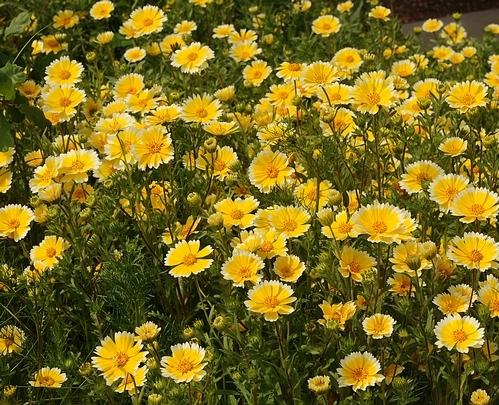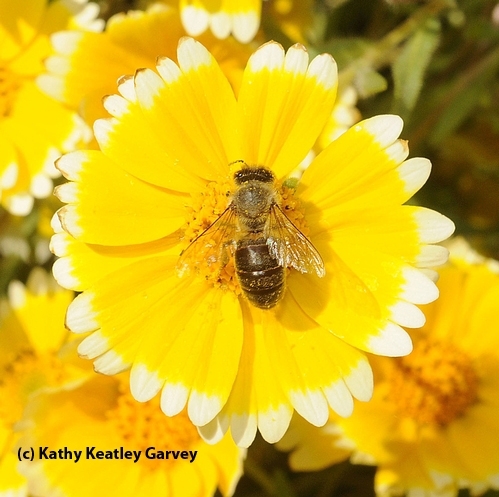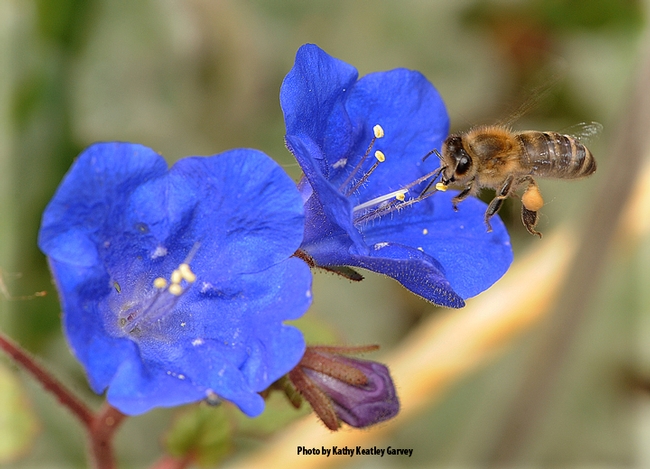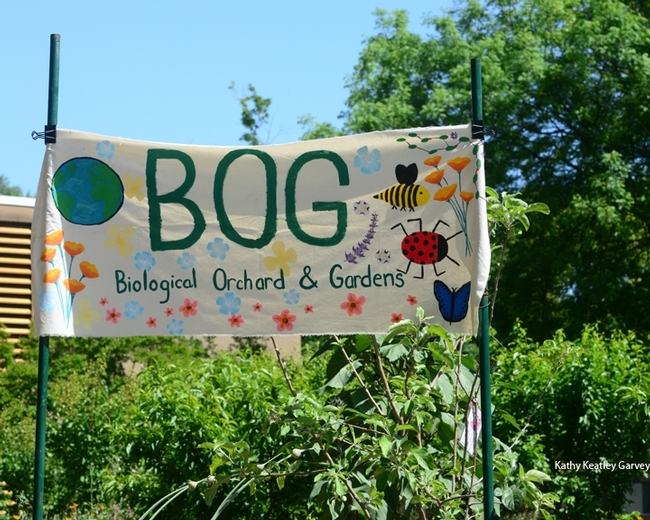
When you attend the UC Davis Biodiversity Museum Day on Saturday, Feb. 15, you'll see these California natives blooming in the Biological Orchard and Gardens (BOG), a 24,000-square-foot treasure behind the UC Davis Botanical Conservatory off Kleiber Hall Drive.
The ninth annual Biodiversity Museum Day, a science-based day that's free and family friendly, will take place from 9 a.m. to 4 p.m. and showcase 13 museums or collections, including the Botanical Conservatory, managed by curator Ernesto Sandoval.
BOG is a living museum, planted not only with several dozen species of heritage fruit trees, but landscaped with colorful mini-gardens.
Among the flowers blooming in the BOG in the early spring, by color:
- Red: European red flax, Linum grandiflorum rubrum, an annual that's native to Algeria
- Yellow: tidy tips, Layia platyglossa, an annual that's native to California
--The seep monkey flower, Mimulus guttatus, native to California
--Lupine, Lupinus, native to North America. - Blue: Desert bell, Phacelia campanularia, an annual herb that is native to California and endemic (limited) to California.
- Lavender: Phacelia, also called Lacy phacelia, blue tansy or purple tansy (Phacelia tanacetifolia), native to the southwestern United States
--Lupine: Lupinus, native to North America - Red-Orange-Yellow: Blanket flower or Gaillardia (Gaillardia × grandiflora), native to North and South America
- Orange: California golden poppies, Eschscholtzia californica

The orchard contains heritage fruit tree varieties threatened with commercial extinction. They include the Gravenstein and Johnathan apples; the Suncrest peach; the Bleinheim apricot, the Mariposa plum and the Meyer lemon. See the full list of trees as well as some fun facts here: https://thebogatucd.wixsite.com/bogucd/single-post/2017/07/18/BOG-Fruit-Trees.
UC Davis Biodiversity Museum Day
The ninth annual UC Davis Biodiversity Museum Day is billed as a “free, educational event for the community where visitors get to meet and talk with UC Davis scientists from undergraduate students to staff to emeritus professors and see amazing objects and organisms from the world around us,” according to Biodiversity Museum Day coordinator Tabatha Yang, education and outreach coordinator for the Bohart Museum of Entomology. Last year's event drew more than 4000 visitors. The event is always held the Saturday of Presidents' Day weekend.
The schedule is online at http://biodiversitymuseumday.ucdavis.edu/schedule.html.
Participating museums or collections and the hours they will be open:
- The Botanical Conservatory, the Greenhouses along Kleiber Hall Drive, will be open from 9 a.m. to 4 p.m.
The following five will be open from 9 a.m. to 1 p.m.:
- Arboretum and Public Garden, Shields Oak Grove, alongside the Vet School, Garrod Drive on campus
- Bohart Museum of Entomology, Room 1124 and Main Hall of the Academic Surge Building, Crocker Lane
- California Raptor Center, 340 Equine Lane, off Old Davis Road
- Museum of Wildlife and Fish Biology, Room 1394 and Mail Hall, Academic Surge Building, Crocker Lane
- Paleontology Collection, Earth and Physical Sciences Building, 434 LaRue Road
Two collections will be open from 10 a.m. to 2 p.m.:
- Phaff Yeast Culture Collection, Robert Mondavi Institute of Wine and Food Science, 392 Old Davis Road, on campus
- Viticulture and Enology Culture Collection, Robert Mondavi Institute of Wine and Food Science, 392 Old Davis Road, on campus
These five will be open from noon to 4 p.m.:
- Anthropology Museum, 328 Young Hall and grounds
- Center for Plant Diversity, Sciences Laboratory Building, off Kleiber Hall Drive
- Häagen-Dazs Honey Bee Haven, Bee Biology Road, off Hopkins Road (take West Hutchison Drive to Hopkins)
- Nematode Collection, Sciences Laboratory Building, off Kleiber Hall Drive
- Marine Invertebrate Collection, Sciences Laboratory Building, off Kleiber Hall Drive
All 13 sites are within walking distance except for the Häagen-Dazs Honey Bee Haven on Bee Biology Road and the Raptor Center on Old Davis Road. Further information, including a campus map, is available on the UC Davis Biodiversity Museum Day website. Maps will be distributed at the 13 sites.
Attached Images:

